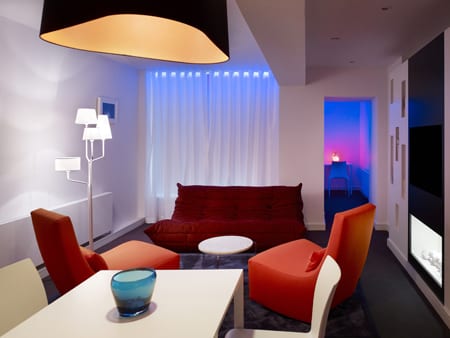Hospitality Design (HD) magazine and Culintro, a culinary trade organization in New York City that brings together restaurant professionals, have teamed up to bring a monthly online Q&A with some of the nation’s top restaurant designers. Each month, we will feature a Q&A with an industry leader, talking about his/her newest project, the industry, what works, and what’s next.
 Andre Kikoski
Andre Kikoski
Andre Kikoski Architect
New York City
www.akarch.com
It’s no surprise that Andre Kikoski has made a name for himself in the design world. He has a master’s degree in architecture from Harvard, and he cut his teeth with such icons as Peter Eisenman, Richard Meier, and I.M. Pei. After he ventured out on his own, he burst on the hospitality scene with Suba restaurant in New York, which grabbed a James Beard nomination for Outstanding Restaurant Design. Since then he has designed a handful of other restaurants in New York (most recently the Wright at the Guggenheim), as well as Chicago, Seattle, San Diego, and Denver. Now, he has branched out to hotels and has custom furniture and lighting lines all under development. But hospitality isn’t his own success story: "Our passion for material research, our detail-orientation, and our client-centric approach have won the firm clients in a wide range of categories—from hospitality to arts and culture, from real estate to high-end residential," he says. We caught up with him to discuss simplicity as a virtue, the importance of Ray and Charles Eames, and Michelangelo’s unlikely relevant advice for today.
 HD: Did you always know you wanted to be an architect?
HD: Did you always know you wanted to be an architect?
AK: Always, ever since my first Lego set. And its fun to watch my six-year-old son be equally enamored with his as well.
HD: Why hospitality? What do you love about it?
AK: Hospitality is the perfect design opportunity—it challenges us to create drama and inviting intimacy, and to craft iconic statements that will stand the test of time. We love these challenges.
HD: Speaking of challenges, what’s the biggest challenge in hospitality today?
AK: In any industry, and now especially, budgets are at the forefront of everyone’s minds. We are committed to artistic innovation regardless of budget, genre, or client challenge, and find inspiration in a modesty of means.
HD: Have to ask, how are you faring in this economy?
AK: We have made simple adjustments and strive to work with a great effectiveness, so we are holding our own at the moment.
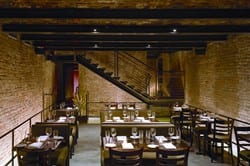 HD: Your big break into hospitality was Suba. What was it about that project that you think won people over?
HD: Your big break into hospitality was Suba. What was it about that project that you think won people over?
AK: I think it was surprising and delightful, and edgy and warm all at the same time. Back then, the Lower East Side was still very gritty, and to find an enchanting series of rooms, one more wonderful than the next, in the basement of a tenement near Delancey Street was totally unexpected. And then there was the Grotto, a room surrounded by 7,000 gallons of water, where diners sat on a floating island while subtly moving reflections (from lights submerged in the water) danced up the original brick walls. It was pure magic!
HD: Let’s talk about some of the other restaurants you have designed. Dessert bar P*ONG, also in New York City, packs a lot of punch in a small space (650 square feet). How did you create drama in such a limited area?
AK: We started designing by looking at photos of dishes from Chef Ong’s new cookbook. They were mesmerizing; colorful morsels that were visually saturated and aesthetically rich. We strove to capture those qualities in a small space with complementary materials, thoughtful lighting, and exciting forms. Given the diminutive size of P*ONG, they became all the more animated by our passion for his food.
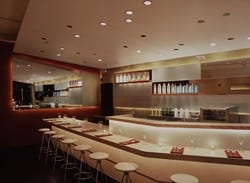 HD: On the West Coast you designed Kitchen 1540 in the renovated L’Auberge hotel in Del Mar, California. How was it working on such a classic hotel? What was your design aesthetic there?
HD: On the West Coast you designed Kitchen 1540 in the renovated L’Auberge hotel in Del Mar, California. How was it working on such a classic hotel? What was your design aesthetic there?
AK: Our goal there, unlike our Manhattan projects, was to create a sophisticated beach vibe that is both elegant and relaxed. We looked to the jewel tones of the pacific sunsets, and the lush garden surrounding our space for inspiration, and were able to create a unique identity for the hotel that has been incredibly successful for their business—even in this economy, their numbers are up several hundred percent!
HD: Most recently, you did the Wright at the Guggenheim. What did you want to bring to such a famous institution as the Guggenheim?
AK: As this restaurant is the first interior addition to the Guggenheim Museum, our intent was to complement the celebrated building and push the limits of contemporary design. We embraced this opportunity to animate the sculptural quality of the building by transforming Wright’s underlying architectural geometries into nuanced, playful forms. The series of sweeping, undulating, and torqued elements are crafted from innovative, contemporary materials. Their surface textures embody movement, creating an ever-changing aesthetic that is enlivened with subtle layers of illumination and glowing tiers of light that envelope the room. The space achieves an elegant and dynamic setting for dining that both celebrates the museum and transcends it.
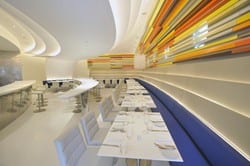 HD: It seems destination restaurants within museums are on the rise (check out HD‘s March issue). At least in New York. What other "trends" do you see happening in the restaurant industry?
HD: It seems destination restaurants within museums are on the rise (check out HD‘s March issue). At least in New York. What other "trends" do you see happening in the restaurant industry?
AK: Now more than ever, I think the basic proposition of any hospitality project has to be carefully nuanced and thoughtfully executed to create a singular kind of experience for guests and patrons. People want the excitement of a special and authentic experience, whether that means sitting in an intimate space with a celebrated chef working just feet in front of them, or in a contemporary room that transforms an iconic work of architecture.
HD: Bringing architectural elements into a restaurant is something you have been very successful at. Can you talk to us about creating a space that has depth through architectural details?
AK: We practice a philosophy of design that is to reward people for looking carefully. In fact, we like to say that the closer you look, the better it gets! This translates into highly tactile environments that invite touch, and underscore the commitment of our clients to quality and originality. It’s quite amazing when people react so naturally and positively to good design!
HD: What’s one project you loved and why?
AK: The Wright was exhilarating and an incredible honor and to work within such an iconic building. Having a modest budget and only 1,600 square feet in which to work challenged and inspired us to do our best work ever.
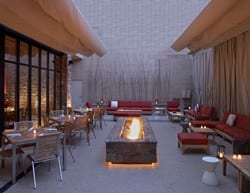 HD: You have worked with many great clients and chefs. What’s the secret to a successful restaurant?
HD: You have worked with many great clients and chefs. What’s the secret to a successful restaurant?
AK: Great lighting and always seeing faces!
HD: What’s your greatest lesson learned?
AK: Simplicity truly is a virtue, and brevity
HD: Any cities you’re watching in terms of design and development?
AK: We are talking to India and China about new projects, which would be fascinating opportunities for us, but mostly we love to see what’s new in New York and Los Angeles.
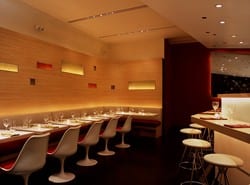 HD: You have worked under some of the best of the best. Is there a designer or architect you admire and why?
HD: You have worked under some of the best of the best. Is there a designer or architect you admire and why?
AK: Ray and Charles Eames expanded our understanding of the breadth of the design disciplines so dramatically, with lasting impact in humble and well thought out projects. That is truly worth emulating!
HD: So many different projects, so little time. How do you constantly find inspiration?
AK: We are so naturally curious, and find inspiration everywhere—but mostly it comes from New York and the stimulating social experience, which constantly introduces exciting new people and ideas.
HD: Do you have a dream project?
AK: The upper deck of a new Airbus A380, and a spa/yoga retreat
deep in the forests of Latin America.
HD: With all of your success, any advice for young designers?
AK: To young designers I would say strive to say what Michelangelo said on his 87th birthday—which was something like ‘I’m still learning’!

